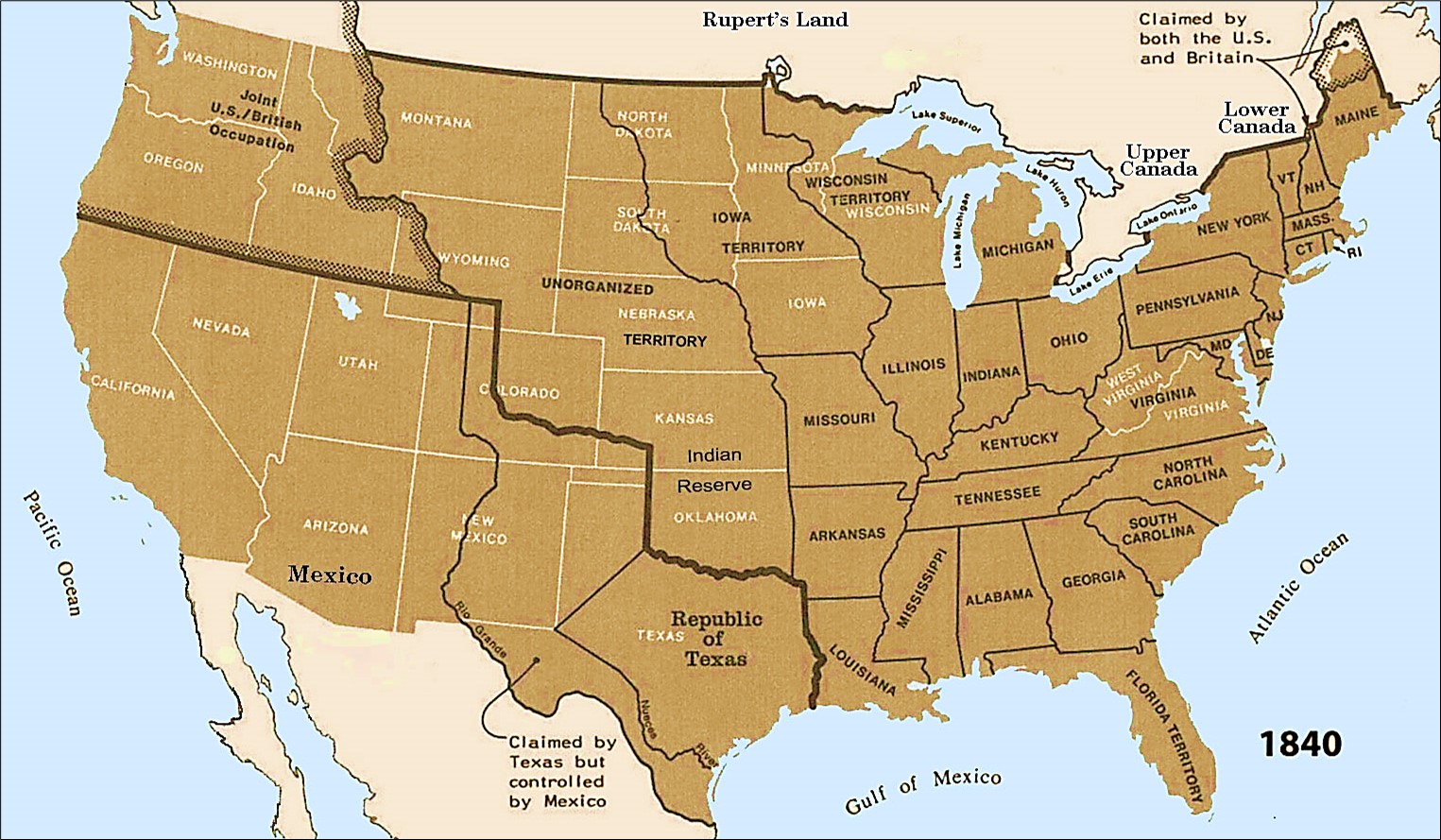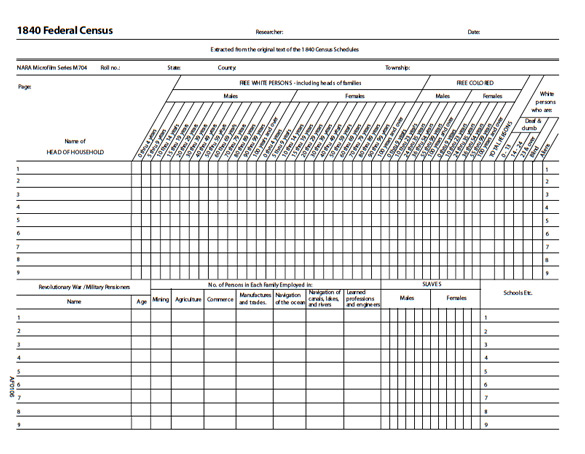The following article was written by my good friend, William Dollarhide. Enjoy…
There are some special aspects to the 1840 federal census that make it one of the most interesting of all censuses taken in the United States since 1790. First, this was the last of the “heads of household” censuses, as the 1850 census was the first to list all members of a household by name. But the 1840 census format had more statistical questions/columns regarding a particular household than any other, including those taken since 1840. There was a total of sixty-six columns of data collected for each household in 1840. In comparison, the 1790 census format had 13 columns of data, while the 1940 census format had 50 columns. Unique to the 1840 census was an array of questions concerning a person’s occupation; including persons engaged in mining, agriculture, commerce, manufacturing, and trades; navigation of the ocean, navigation of canals, lakes, and rivers; and learned professionals and engineers.
Of particular interest to genealogists with ancestors living on or near navigable rivers and lakes was the number of persons in 1840 in a household engaged in river or lake commerce as ferrymen, boatmen, longshoremen, warehousemen, etc., the only time these specific questions were ever asked in any census. This census is a place to learn that an ancestor was engaged in work on the Erie Canal, for example, or, that an ancestor was involved in ocean shipping of some kind.
Also unique to the 1840 census was the special listing of any person in a household who was a Revolutionary War or other military pensioner. As a result, the 1840 census was the first to list the name of another person living in a household other than the head of the house. In 1832, Congress passed legislation that allowed any veteran, right down to a lowly Private, the right to apply for a pension. By then, there were only a handful of Revolutionary War veterans left alive (most of them were in their 80s), but the 1840 census is a place to see the names of the men who were receiving a pension for military service. Such a list was made again for Union veterans of the civil war in 1890. Although certain other censuses did ask if a person was a veteran, the 1840 and 1890 censuses were the only ones where the names of veterans were listed separately.
Content of the 1840 Census
Several categories of questions were asked for the Head of Household, on one line, spread over two large pages of census schedules. In the case of slave owners, they were treated as heads of households of a family, even if they were living with another family. Therefore, in any family including male and female slaves, the head of that household was the slave owner.
● Name of a head of household / Slave Owner (if slaves indicated).
– Number of male slaves, in 6 age categories.
– Number of female slaves, in 6 age categories.
● Name and age of each person receiving Revolutionary War/Military pension.
● Number of free white males, in 13 age categories.
● Number of free white females, in 13 age categories.
● Number of free colored males, in 6 age categories.
● Number of free colored females, in 6 age categories.
● Number of white persons who were deaf & dumb, in 3 age categories.
● Number of white persons who were blind.
● Number of white persons who were aliens (foreigners not naturalized).
● Number of persons engaged in:
– Mining
– Agriculture
– Commerce
– Manufacturing and Trades
– Navigation of the Ocean
– Navigation of Canals, Lakes, and Rivers
● Number of Learned Professionals and Engineers.
● Number of persons attending school.
1840 Map of the United States
Note: 1840 boundaries are in black, and modern boundaries are in white.

The U.S. in 1840
On the census day of June 1, 1840, two new states had been added to the U.S. since the 1830 federal census: 1) Arkansas was admitted in 1836; and 2) Michigan was admitted in 1837, bringing the total of states in the Union to twenty-six. The exiting territory (1821) of Florida was enumerated, as were two new territories, Wisconsin (1836) and Iowa (1838). Wisconsin Territory was carved out of the bounds of Michigan Territory, including part of the area of present-day Minnesota, while Iowa Territory was created from the unorganized territory between the Mississippi and Missouri Rivers. After defeating Mexico in battle, the Republic of Texas was formed in 1836 and was annexed to the U.S. as a state in 1845. The Republic’s claim to lands extended to the Rio Grande, and that claim was to be the basis for the U.S. invasion of Mexico in 1846. There were no district-wide census losses for 1840.
Click on the above map for a full-size printable copy of the 1840 Map of the U.S.A. (Jpeg format – about 5 meg in size) Orient to “landscape” when printing.
Click on the above 1840 census extraction form for a printable full-sized form in PDF format.
Additional Reading
Map Guide to the U.S. Federal Censuses, 1790-1920, Thorndale and Dollarhide.


Where do you find the lower half of that census? All that I have found are the upper part.
Sorry, I missed this comment earlier. The form was designed to show the two page spread of the original census schedules, the upper portion in the left hand page, the lower portion is the right hand page. when reading the images, move to the next image to the right to see the data on the lower portion of the form. -bill$hide
I should like to use the map “1840 Map of the United States” for my upcoming book. The publisher is Lehigh University Press. Who is the map’s copyright holder or is the image fair use? Thank you and take care.
Wiliam Dollarhide is the copyright owner of that map for purposes of this nature. You may contact him at wdollarhide@gmail.com
Thanks,
Leland K Meitzler